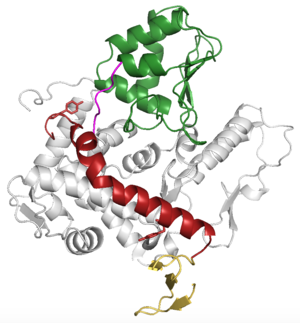WWP2
From Proteopedia
| Line 14: | Line 14: | ||
The <scene name='84/848928/Linkeronly/1'>2,3-linker</scene> is alpha helical in shape. The <scene name='84/848928/Ww2_domain/8'>WW2</scene> domain is a 3 stranded beta sheet. | The <scene name='84/848928/Linkeronly/1'>2,3-linker</scene> is alpha helical in shape. The <scene name='84/848928/Ww2_domain/8'>WW2</scene> domain is a 3 stranded beta sheet. | ||
| - | The HECT domain is divided into two lobes (labeled N and C). There is a <scene name='84/848928/Hinge_zoomed/ | + | The HECT domain is divided into two lobes (labeled N and C). There is a <scene name='84/848928/Hinge_zoomed/6'>hinge</scene> that connects the N and C lobes or this protein. This hinge also interacts with the 2,3-linker. The WW2 domain is a 3 stranded beta sheet. The HECT domain is in an inverse T shape when inactive and takes on an L shape when active. WW2 interaction with HECT is mediated by the six C terminal residues. |
Revision as of 17:36, 18 June 2020
Contents |
Thoughts & Notes
5tjq (2,3-linker) proteopedia page place to input
Introduction
WWP2 (WW domain-containing protein 2) is a type of ubiquitin protein ligase. Ubiquitination can serve as a signal for degradation, lead to translocation within the cell, and result in altered activity and altered protein-protein interactions. The ubiquitination pathway comprises of ubiquitin-activating (E1), ubiquitin-conjugating (E2) and ubiquitin-ligating (E3) enzymes. WWP2 is a member of the HECT (Homologous to the E6-AP Carboxyl Terminus) E3 Ligases class of enzymes. HECT E3 Ligases accept a ubiquitin molecule from E2 enzymes and transfer the ubiquitin to a Lysine residue in the target signaling molecule or transcription factor. The thioester bond formation between an active site Cystine on HECT E3 Ligases and the ubiquitin ligand differentiates the HECT family of enzymes from the more abundant RING (Really Interacting New Gene) family of ubiquitin ligases which mediate ubiquitin transfer through non-covalent interactions. Within HECT E3 Ligases, WWP2 falls into the NEDD 4 family (named after the instance in which the first member was discovered: a study of developmentally down-regulated proteins in neuronal embryonic mouse cells) which generally target proteins with a PPxY motif. NEDD4 E3 Ligases consist of an amino-terminal C2 domain, between two and four WW domains, and a carboxy-terminal HECT domain.
Structure
| |||||||||||
Function
The 2,3-linker plays an autoinhibitory role. Upon phosphorylation the 2,3-linker changes conformation, allowing the protein to bind ubiquitin in the E2 binding site. This binding will further open the protein up to bind possible substrates.
Relevance
References
1. Chen, Z., Jiang, H., Xu, W., Li, X., Dempsey, D. R., Zhang, X., . . . Cole, P. A. (2017). A Tunable Brake for HECT Ubiquitin Ligases. Molecular Cell, 66(3), 345-357. doi:10.1016/j.molcel.2017.03.020 PMID:28475870
2. Ingham, R.J., Gish, G., & Pawson, T.(2004) The Nedd4 family of E3 ubiquitin ligases: Functional diversity within a common modular architecture. Oncogene, 23(11), 1972-1984. doi:10.1038/sj.onc.1207436
Proteopedia Page Contributors and Editors (what is this?)
Tihitina Y Aytenfisu, Hannah Campbell, Sandra B. Gabelli, Michal Harel

